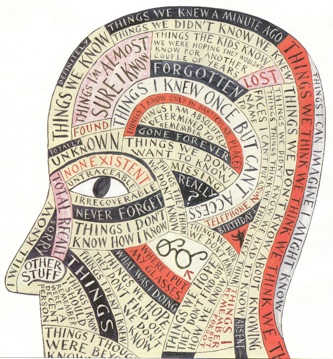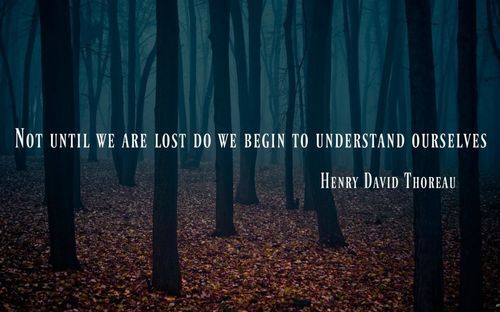
Metacognition is the mind-map that is the survival tool in reading comprehension: it is that ‘thinking about thinking,’ the big picture, and knowing where you’re going, and, perhaps more importantly, when you’re lost:
Anagnorisis is the moment in the story where the character, usually the protagonist, says, “Uh-oh.”
According to Merriam-Webster, it is:
Main Entry: an·ag·no·ri·sis
Pronunciation: \ˌa-ˌnag-ˈnȯr-ə-səs\
Function: noun
Inflected Form(s): plural an·ag·no·ri·ses
\-ˌsēz\
Etymology: Greek anagnōrisis, from anagnōrizein to recognize, from ana- + gnōrizein to make known; akin to Greek gnōrimos well-known, gignōskein to come to know — more at know
Date: circa 1800
: the point in the plot especially of a tragedy at which the protagonist recognizes his or her or some other character’s true identity or discovers the true nature of his or her own situation
We teachers are merely the sherpas to our students’ quests for higher learning, deeper thinking, with all the oxygen and rations they need at K-2, or Knowledge Exponential 2 Base Camp. The reason this post begins with with ‘metacognition’ and ‘anagnorisis’ is because we want our students to realize that they’re doing both — they need to recognize that ‘oh, snap!’ moment when they’re lost in their understanding of any reading material. And, it’s our worthy task to help them find their way up, and safely back down, the moutain.
Any. Reading. Material.
And before I go further, I am compelled to acknowledge and recognize one of the greatest teachers, my master’s mentor, Dr. Candace Shulhauser. She helped synthesize for me everything I know about metacognition, Before, During, and After, and helped guide me through my first novel guide/unit. She took all of the great information out there, made us all see clearly and with strength, and added her own personal experiences and narrative to the mix to make it truly meaningful. She was there, making it happen for the hardest and most challenging of students, and showed us that it can be done with grace, courage, and wisdom. Thank you. (And yes, I think it’s super cool that her name takes on a Dickensian edge meaning “candy schoolhouse.” How sweet!)
Over time, one of the most fundamental alterations that has taken place in my own brain is I have a hard time reading books now without looking at them through the eyes of a teacher. In some ways, this kind of stinks, like a busman’s holiday. I am constantly looking for a myriad of functions and examples in books. This summer, for the first time in years, I put my book-brain on ice. Yesterday I was vindicated for doing so by a quote from Charles Bukowski–in essence, sometimes it’s good to do nothing for awhile. And this summer, I did, oh boy, did I. But more on my ‘do nothing’ summer later.
So, the point is, while I have a hard time reading anything without making a novel guide out of it, I will share some of my processes, and how I synthesized the processes of other great reading teachers, such as Jim Burke, Kelly Gallagher, Nancy Atwell, Kylene Beers, etc. (There is not much of a difference, in my estimation, of teaching a novel and teaching someone how to read. It’s all about access. To get into the nuances between teaching great “literature” and teaching reading, well, I’m just not up for that one right now.)
So, I have never read The Thief Lord by Cornelia Funke. It was a very popular book several years ago, and she is a wonderful children’s author. This summer, in between long stretches of some serious goofing-off, I decided to read it. (My younger son said it was a read-aloud when he was in fourth grade. That’s too bad, because now he won’t touch it. Again, blog posting for another day.) I haven’t finished it yet, so don’t be a spoiler.
- The front cover tell me has a person wearing a cloak, making only a shadow with a full, bright moon. Hmmm, I wonder if that person is the thief lord?I know what a thief is, and a lord is someone powerful…
- The back cover has a blurb. STOP – introduce the book and show students all of these things. This is how they might find something they want to read. Yes, teach them to judge a book by its cover, but take time to make an informed decision!
- The story takes place in Venice. How do I know? This is when you STOP — time to teach some background knowledge:
 You can click on this image to view larger, of course. Here’s where some decisions need to be made: depending on your students and access to technology/information, you will want to decide how much you want to give and how much inquiry you want them to create. Here’s the deal, though, with our brains, we love patterns. So, if students get misinformation or misconceptions about what they’re inquring about, to re-wire these pathways will be doubly difficult. Inquiry and constructivism are wonderful tools–but remember, if someone doesn’t know anything about a topic, the potential for missteps grows. Imagine you’ve never been to Venice (like I have never been) or seen a picture, or been on a canoe, or little boat, or imagined a city built entirely around canals, with bridges, and ancient pathways, nooks, crannies, or have ever heard of Italy at all? This is part of a safe environment of learning. It’s okay not to know, but not okay not to learn. (I didn’t know for a long time that the ‘underground railroad’ wasn’t like a subway. I’ve had students who believed the same thing. I had a student from New York City tell girls about subways, and they didn’t believe him. It goes on…)
You can click on this image to view larger, of course. Here’s where some decisions need to be made: depending on your students and access to technology/information, you will want to decide how much you want to give and how much inquiry you want them to create. Here’s the deal, though, with our brains, we love patterns. So, if students get misinformation or misconceptions about what they’re inquring about, to re-wire these pathways will be doubly difficult. Inquiry and constructivism are wonderful tools–but remember, if someone doesn’t know anything about a topic, the potential for missteps grows. Imagine you’ve never been to Venice (like I have never been) or seen a picture, or been on a canoe, or little boat, or imagined a city built entirely around canals, with bridges, and ancient pathways, nooks, crannies, or have ever heard of Italy at all? This is part of a safe environment of learning. It’s okay not to know, but not okay not to learn. (I didn’t know for a long time that the ‘underground railroad’ wasn’t like a subway. I’ve had students who believed the same thing. I had a student from New York City tell girls about subways, and they didn’t believe him. It goes on…)
So, short or long lessons, and time spent on Venice. Your choice, and your students’ needs.
Next, annotating text: I had a big lesson myself when teaching annotating text. Thought students were ‘getting it,’ and doing okay. Asked a girl how her annotating this one Greek story was coming along, and she answered confidently, “great!’ Something told me to stop and ask her to explain the first paragraph. She didn’t know every other third word. Okay, let’s try again – highlight the words that seem confusing. And I tried to sweeten the deal with reaffirming again that the more one reads, the more automatic understanding/fluency becomes, and the more fun it is to read.
Like I said, I can’t read a book anymore in the same way. It’s just now my job means I make my brain processes as transparent as possible so students can look inside my head, so they are better at looking inside theirs.
There are many ways for annoating text; you may decide you want to teach one specific strategy at a time, such as a vocabulary skill for reading comprehension strategy:  In this particular example, the word “vaporetto” is used. I’ve never seen that word before, but the image I put together demonstrates some of my thinking process.
In this particular example, the word “vaporetto” is used. I’ve never seen that word before, but the image I put together demonstrates some of my thinking process.
Another vocabulary buggaboo are context clues. We assume, too often, that students know more than they do. For example, this sentence:
“A party of tourists (blank) past the (blank) while their guide described the (blank) above their heads in a (blank) voice.”
There are four words in that sentence that are potential mental gopher holes: shuffled, confessional, mosaics, and muted.
How would you teach those? Have student act out “shuffled,” look up a confessional, make a connection if they’re Catholic or have been to a Catholic church, infer, what a mosaic is, or look it up, and then maybe make one, and make an educated guess (inference) on if they are in a church, would they be yelling in a loud voice (questioning text)? Not one single reading ‘strategy’ can effectively be taught in isolation, but we don’t think ‘in isolation.’
(*The ‘say blank’ strategy is Dr. Schulhauser’s.)
Allusions are one of my all-time favorite concepts to teach, even though inevitably I will be corrected by a student telling me it’s “ILLusion, Mrs. Love, not ALLusion.” Um, well, no, my darling middle schooler, let me continue…) So far I haven’t found any specific allusions in The Thief Lord, although there are plenty of connections. An allusion is a specific reference to another work/character. The connections are abundant. It’s Oliver Twist, The Goonies, and The Pink Panther/Inspector Clouseau to start. But, boy howdy, when you use your strong metacognitive skills and spot an allusion, it’s like a reading golden ticket. Allusions to other works show us that we are not learning in isolation, that we are connected, and our thinking, based on knowledge. Now I can’t get Led Zeppelin’s Immigrant Song out of my head, when Robert Plant wails, “To fight the horde, to sing and cry, Valhalla, I am coming…” If you remember your sixth grade Norse mythology, you know what Valhalla is, and why you may want to go there someday. Or, at least, what the Minnesota Vikings might want to sing in the locker room showers. In my goofing-off summer, there are so many allusions in this game I play, but it makes me laugh when I recognize something, such as little goblin men speaking the words of Elton John’s Rocket Man to each other in conversational tones. (And for the record, Rocket Man is the only song I can sing and score big on Guitar Hero.) Allusions add a richness and texture to our reading/listening/viewing that would otherwise be lacking. Teach them as part of metacognition to students recognize those connections to other works when they read/see/hear them. We all feel smarter and more creative when we do.
Characterization and connections lead me to themes…
But another day. Ciao, bella!
Postscript: If you would like some of the excerpt .jpgs for your own classroom instruction, send me a Tweet @mrskellylove and your e-mail address; that is, if the links don’t work.








